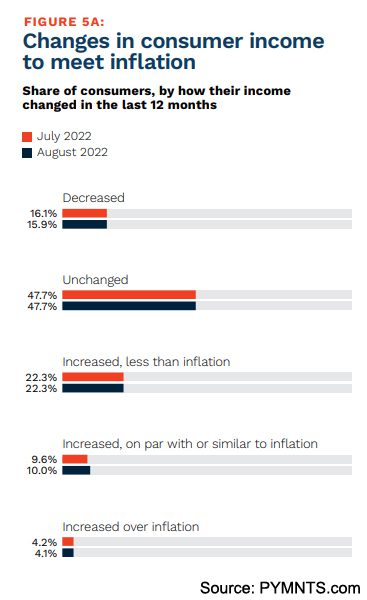Slumping Confidence + Rising Labor Costs = Trouble on Main Street

There are economic cycles, there are business cycles and sometimes there are vicious cycles.
If a mounting mix of new headwinds has it right, then we may be headed towards the latter right now as a perfect storm could be taking shape, and Main Street SMBs look to be right in its path.
Triangulating a string of data points leads to a pattern of softening business demand and continued margin pressure, possibly even a shakeup of the labor force that in turn pressures SMBs’ survivability.
As reported by PYMNTS on Tuesday (Oct 25) and with research done in collaboration with LendingClub, via the “New Reality Check: The Paycheck-To-Paycheck Report,” two-thirds of consumers state that they are dissatisfied with their pay.
Simply put, the paychecks don’t match the pressures in an environment where 63% of us live paycheck to paycheck. A minuscule 4% of consumers overall (whether living paycheck to paycheck or not) say their wages, through the past year, have increased more than inflation. This would imply of course, that purchasing power also has increased (and by extension, consumers would be inclined to buy more).

The data in the P2P report show that 40% of consumers depend on their jobs to bring in the majority of their household income — 75% of that income comes from employment, even if there are other sources of earnings. Four in 10 households have one significant breadwinner, so by default, the strategy to boost purchasing power would be to find another job with higher paychecks or to pressure current employers to boost wages.
A third of the more than 3,900 consumers state that they think they could switch jobs to find a job paying the wages that they need — it’s not a majority, we note, but it’s a significant number.
Separately, data just released by the Conference Board show that, as measured by the Present Situation Index — based on consumers’ assessment of current business and labor market conditions — we’re seeing some pessimism, as the reading declined sharply to 138.9 from 150.2 last month. The Expectations Index — based on consumers’ short-term outlook for income, business and labor market conditions — declined to 78.1 from 79.5. Drilling down a bit, consumers’ assessment of current business conditions declined a bit as 17.5% of consumers said business conditions were “good,” down from 20.7%. 24.0% of consumers said business conditions were “bad,” up from 20.9%.
As for the jobs market: 45.2% of consumers said jobs were “plentiful,” down from 49.2% — not a majority, but a significant percentage.
And here is where the clouds gather for Main Street SMBs.
The job is always in focus for the paycheck-to-paycheck consumer, where PYMNTS has found that as many as three in 10 workers will change jobs within the next six months. Our report states that “42% lower-income consumers are not very or extremely likely to have the same job in six months, as are less than 15% of consumers in the highest income brackets.” There’s the old adage that applies to many things, and especially the job market: Striking while the iron is hot (or at least warm).
Turnover looms at the same time macro uncertainly looms. Thus, to remain competitive, employers must always be mindful of the wages they pay even if, as the Fed’s Beige Book has found, “employment continued to rise. But some districts reported a cooling in labor demand .”
Separate PYMNTS reports show that 46% of Main Street SMB owners say they have increased wages or workers’ hourly rates. The pressures are such that 12% of Main Street SMBs are worried they may not survive past 2024.
SMBs cannot simply keep paying higher wages to keep P2P consumers working for them; yet if they lose them, it’s tougher to stay in business. The added ripple effect would be that any boost in the unemployment rosters would make things tougher for P2P consumers seeking new job opportunities…and the vicious cycle takes shape.
For all PYMNTS B2B coverage, subscribe to the daily B2B Newsletter.